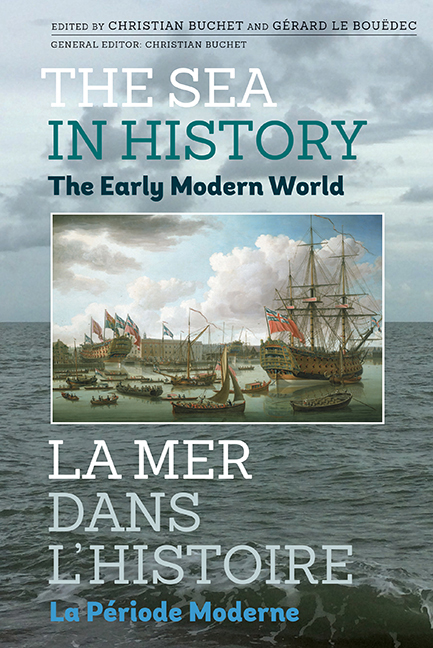Book contents
- Frontmatter
- Contents
- List of Illustrations
- List of Contributors
- Introduction générale et remerciements par
- General introduction and acknowledgements
- Introduction (français)
- Introduction (English)
- LA RÉUSSITE PAR LA MER:La reussite par la mer des territoires et des communautés littorales
- La construction d'un espace mondial: La circulation maritime et les ports
- La forte croissance de l'économie des pêches et des échanges
- Les acteurs de la dynamique maritime
- LA PUISSANCE MARITIME INSTRUMENT DE LA PUISSANCE POLITIQUE ET D'UNE STRATÉGIE GLOBALE DE RAYONNEMENT VOIRE DE DOMINATION: Les puissances maritimes occidentales
- L'océan Indien, entre convoitises et indifférences
- Les puissances maritimes asiatiques
- L'Afrique
- La politique maritime et l'idéologie
- Mer et développement technologique
- Développement maritime et maîtrise économique et financière
- Développement maritime et maîtrise organisationnelle
- Conclusion (français)
- Conclusion (English)
- Conclusion générale par
- General conclusion by
- Miscellaneous Endmatter
- Miscellaneous Endmatter
Conclusion (English)
Published online by Cambridge University Press: 11 May 2017
- Frontmatter
- Contents
- List of Illustrations
- List of Contributors
- Introduction générale et remerciements par
- General introduction and acknowledgements
- Introduction (français)
- Introduction (English)
- LA RÉUSSITE PAR LA MER:La reussite par la mer des territoires et des communautés littorales
- La construction d'un espace mondial: La circulation maritime et les ports
- La forte croissance de l'économie des pêches et des échanges
- Les acteurs de la dynamique maritime
- LA PUISSANCE MARITIME INSTRUMENT DE LA PUISSANCE POLITIQUE ET D'UNE STRATÉGIE GLOBALE DE RAYONNEMENT VOIRE DE DOMINATION: Les puissances maritimes occidentales
- L'océan Indien, entre convoitises et indifférences
- Les puissances maritimes asiatiques
- L'Afrique
- La politique maritime et l'idéologie
- Mer et développement technologique
- Développement maritime et maîtrise économique et financière
- Développement maritime et maîtrise organisationnelle
- Conclusion (français)
- Conclusion (English)
- Conclusion générale par
- General conclusion by
- Miscellaneous Endmatter
- Miscellaneous Endmatter
Summary
Between the sea and the hinterland, a new triumphant model of economic development of territories and their populations emerged, which helped to progressively create a global world. Ports, controlled by states and investors who provided an impetus for dense maritime traffic administered by increasingly internationalised seafaring communities, were at its core. Port cities became the mirrors of this new world order. Achieving success by the sea was of course important, but dominating by the sea became for some states an ambition that inspired a strategy of power and domination, even if power combined with economic, social and political modernity was a necessary, and therefore discriminatory condition.
BETWEEN SEA AND HINTERLAND, A NEW MODEL OF ECONOMIC DEVELOPMENT
The growth and diversity of the flows of goods was impressive. Staple foods were the essence of this trade-based economy. As a result of maritime transportation development, the sea profoundly disrupted the agriculture of coastal hinterlands, by first increasing the trading of crops in shortage areas, which stimulated cabotage connections in all the European, African, American and Asian coastlines, then leading to selective agricultural specialisations, and finally promoting cultivation of crops from overseas such as corn and potatoes. However, to meet the growing demand, single crops in the colonies – sugar cane, coffee, tobacco, tea and spices – became monocultures that were often transplanted to areas where they had never existed before, replacing subsistence crops. In Europe, wine held a special place among these products. Wine played a driving role in the expansion of maritime trade – both marketed in Europe and intended for colonial lands – thereby encouraging vineyards growth. In the early 16th century, three main trade flows coexisted to supply the major destinations of Northern European markets: Mediterranean sweet wines, young white wines from the Rhine Valley, sweet and dry white wines and red wines from Atlantic vineyards, particularly the Bordeaux and Gascony regions. The latter became popular in Northern Europe and in the colonial, promoting and increasing the consumption of red wine. Salt routes also contributed to structuring trade circuits between Northern Europe and the ports of the Atlantic and Mediterranean salt marshes. Salt was vital in the agriculture and fishing industry, and essential to balance the exchanges between Northern and Southern Europe.
- Type
- Chapter
- Information
- The Sea in History - The Early Modern World , pp. 942 - 976Publisher: Boydell & BrewerPrint publication year: 2017



